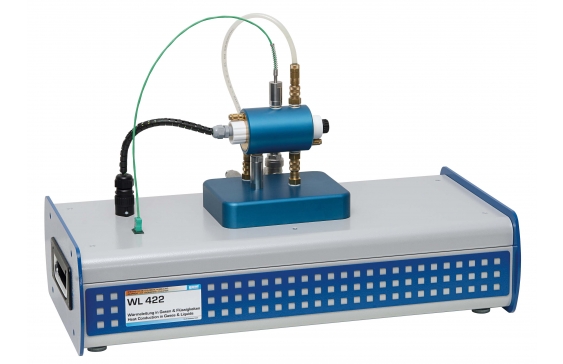WL 422 Heat conduction in fluids

Heat conduction is one of the three basic forms of heat transfer. According to the second law of thermodynamics, heat is always transferred from the higher energy level to the low energy level.
WL 422 offers basic experiments for targeted teaching on the topic of heat conduction in fluids. Such teaching should discuss the fundamental differences between gases and liquids.
Two cylinders form the main component of the experimental unit: an electrically heated inner cylinder situated in a water-cooled outer cylinder. There is a concentric annular gap between the two cylinders. This annular gap is filled with the fluid being studied. The heat conduction occurs from the inner cylinder, through the fluid to the outer cylinder. The narrow annular gap prevents the formation of a convective heat flux and allows a relatively large pass-through area while at the same time providing a homogeneous temperature distribution.
The experimental unit is equipped with temperature sensors inside and outside of the annular gap. Thermal conductivities for different fluids, e.g. water, oil, air or carbon dioxide can be determined in experiments.
The microprocessor-based instrumentation is well protected in the housing. The GUNT software consists of a software for system operation and for data acquisition and an educational software. With explanatory texts and illustrations the educational software significantly aids the understanding of the theoretical principles. The unit is connected to the PC via USB.
- effect of different fluids on heat conduction
- functions of the GUNT software: educational software, data acquisition, system operation
- part of the GUNT-Thermoline: Fundamentals of Heat Transfer
Heater
- heating power: 350W
- temperature limitation: 95°C
Heat transfer area: 0,007439m2
Annular gap
- height: 0,4mm
- average diameter: 29,6mm
Inner cylinder
- mass: 0,11kg
- specific heat capacity: 890J/kg*K
Measuring ranges
- temperature: 2x 0…325°C
- heating power: 0…450W
230V, 50Hz, 1 phase
230V, 60Hz, 1 phase; 120V, 60Hz, 1 phase
UL/CSA optional
- investigation of the thermal conductivity of common fluids, e.g. water, oil, air or carbon dioxide
- concentric annular gap between 2 cylinders containing the fluid being studied
- inner cylinder, continuously electrically heated
- water-cooled outer cylinder
- display of temperatures and heating power in the display
- microprocessor-based instrumentation
- functions of the GUNT software: educational software, data acquisition, system operation
- GUNT software for data acquisition via USB under Windows 7, 8.1, 10
- steady heat conduction in gases and liquids:
- determine the thermal resistance of fluids
- determination of thermal conductivities k for different fluids at different temperatures
- transient heat conduction in fluids:
- interpret transient states during heating and cooling
- introduction to transient heat conduction with the block capacity model
